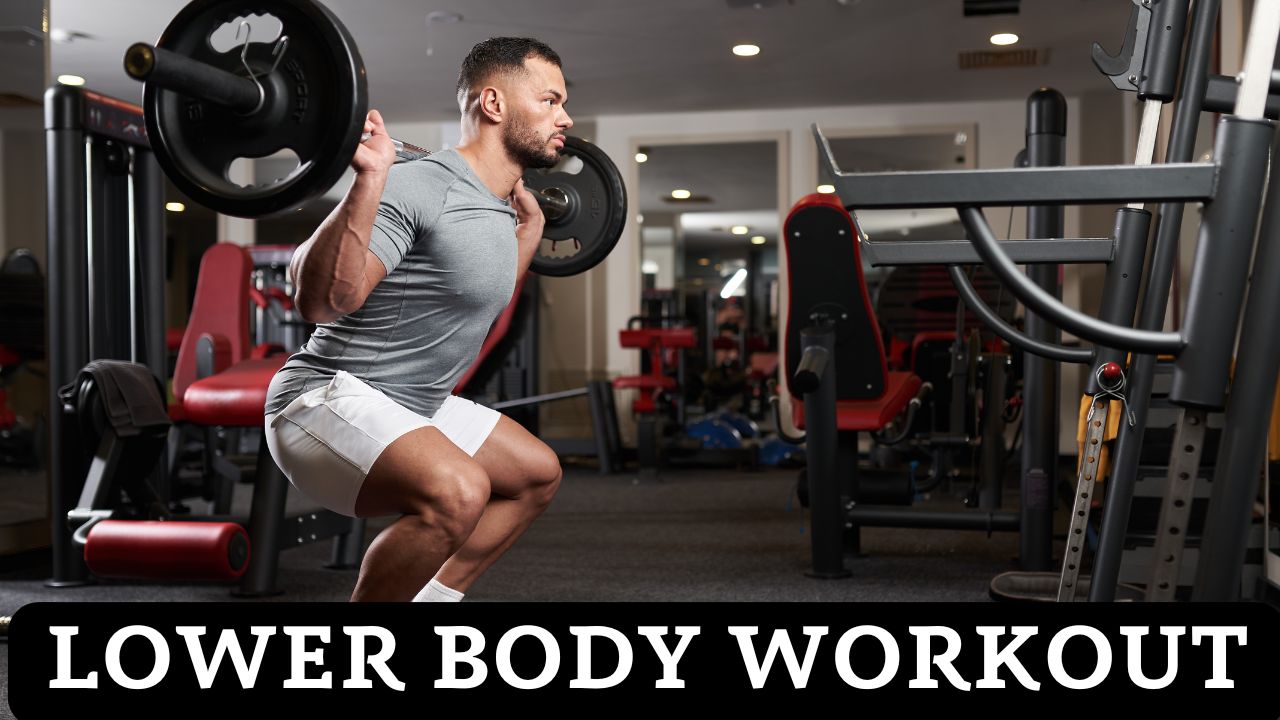LOWER BODY WORKOUT
Create your personalized lower body workout program with our AI-powered planner. Get tailored routines that match your goals, experience level, and equipment preferences.

BASIC WORKOUT INFORMATION
Training Focus
Available Equipment
Health & Limitations
Lower Body Workout Program
This comprehensive lower body workout program is based on cutting-edge scientific research and evidence-based training principles. Strong legs and glutes are not only aesthetically appealing but also form the foundation for overall athletic performance, functional capacity, and injury prevention. This program incorporates proven exercises and training methodologies for maximizing strength, power, and muscle development in the quadriceps, hamstrings, glutes, and calves.
Research-Backed Lower Body Training Evidence
Lower Body Strength & Performance Transfer
A comprehensive meta-analysis published in Research Gate (Seitz et al.) examined the relationship between lower-body strength improvements and athletic performance. The research conclusively demonstrated that increases in lower-body strength positively transfer to improved sprint performance with a large effect size (ES = 0.77). This indicates that dedicated lower body resistance training not only builds muscle but directly enhances functional athletic capabilities. The study particularly highlighted the effectiveness of combined squat and plyometric training for maximizing transfer to sport-specific performance.
Hormonal Response & Muscle Development
Research published in The International Journal of Exercise Science investigated hormonal responses to different types of lower body resistance exercises. The findings showed that lower body training involving large muscle groups produces significant acute increases in anabolic hormones like growth hormone and testosterone. Most notably, the research demonstrated that exercises like squats performed with appropriate depth (thighs at least parallel to floor) elicit greater hormonal responses compared to partial range of motion exercises, contributing to enhanced whole-body muscle development through systemic effects.
Optimal Training Modalities & Methods
A comprehensive narrative review published in Research Gate analyzed various strength training modalities for lower body development. The review found that a combination of traditional heavy resistance training (≥85% 1RM), moderate-load training with intentional velocity (60-80% 1RM), and specialized techniques like velocity-based training produced optimal results for strength and power development. The research emphasized that periodized programs incorporating multiple loading strategies and movement patterns were superior to single-modality approaches for continued progression and injury prevention.
Lower Body Training Principles
Movement Pattern Selection
Effective lower body development requires training across fundamental movement patterns rather than isolated muscles. According to biomechanical research, a complete lower body program should include knee-dominant movements (squats, leg extensions), hip-dominant movements (deadlifts, hip thrusts), single-leg exercises (lunges, split squats), and calf-specific movements. This comprehensive approach ensures balanced muscular development while promoting functional strength and reducing injury risk by addressing common muscular imbalances between quadriceps and hamstrings. Research specifically recommends maintaining a hamstring-to-quadriceps strength ratio of at least 0.6 for optimal knee health.
Progressive Overload & Volume Management
Scientific literature from indicates that lower body muscles, particularly the quadriceps and glutes, respond optimally to higher training volumes compared to upper body muscles. Research shows that each major lower body muscle group should receive approximately 12-20 weekly sets for maximum hypertrophy, with intensity primarily in the 70-85% 1RM range (6-12 repetitions per set). For optimal strength development, studies recommend including periodic phases of higher intensity (>85% 1RM) with lower repetitions (1-5 per set). Progressive overload—gradually increasing the demands placed on the musculature—remains the fundamental principle for continued adaptation.
Best Lower Body Exercises
Barbell Back Squat
The barbell back squat is widely considered the cornerstone of lower body development. EMG studies show it activates approximately 200 muscles throughout the body, with primary activation in the quadriceps, gluteals, adductors, and erector spinae. Research from PubMed (Jakobsson et al.) indicates that squats performed to proper depth (hip crease below parallel) generate significantly greater muscle activation and hormonal response compared to partial squats. For optimal development, a variety of squat stances can be implemented, with wider stances increasing gluteal and adductor involvement and narrower stances emphasizing quadriceps activation.
Romanian Deadlift
The Romanian deadlift (RDL) is the premier exercise for hamstring development. Biomechanical analysis shows that the RDL creates maximal tension through the hamstrings at their lengthened position, making it particularly effective for hypertrophy and injury prevention. Research demonstrates significant activation of the entire posterior chain, including the hamstrings, gluteals, and erector spinae. The exercise’s emphasis on eccentric control—where the muscle lengthens under tension—is especially valuable since studies show eccentric training produces greater hypertrophic responses and protective adaptations against muscle damage compared to concentric-only training.
Hip Thrust
The barbell hip thrust has emerged as a scientifically validated exercise for gluteal development. EMG studies consistently show it produces higher gluteus maximus activation than squats, deadlifts, or lunges, making it particularly valuable for targeted glute hypertrophy. The horizontal force vector of the hip thrust creates a unique loading pattern that maximizes tension on the glutes at peak contraction. Research indicates that hip thrusts not only build aesthetic glute development but also transfer effectively to improved sprinting speed, jumping ability, and reduced risk of hamstring injuries by improving the posterior chain’s force production capabilities.
Bulgarian Split Squat
As a unilateral exercise, the Bulgarian split squat addresses strength imbalances while providing substantial quadriceps, gluteal, and hamstring activation. Research comparisons with bilateral exercises show that unilateral training produces similar muscle activation with reduced spinal loading, making this an excellent option for those with lower back concerns. Studies indicate that elevating the rear foot increases range of motion and gluteal activation compared to standard lunges. The exercise’s unilateral nature improves balance, coordination, and proprioception while developing lower body strength in a functional pattern that transfers directly to walking, running, and jumping mechanics.
Leg Press
The leg press serves as an effective compound movement for lower body development, particularly for the quadriceps. Biomechanical research shows that foot position significantly alters muscle activation patterns, with higher foot placements increasing hamstring and gluteal involvement and lower foot positions emphasizing quadriceps. The controlled environment of the leg press allows for safely handling heavier loads than free-weight alternatives, making it valuable for progressive overload. Studies also indicate the leg press can be an effective alternative for individuals with mobility limitations or those rehabilitating from certain injuries that prevent proper squatting mechanics.
Standing Calf Raise
The standing calf raise effectively targets the gastrocnemius, which research shows responds best to loaded training in a fully stretched position. EMG analysis demonstrates that standing variations preferentially activate the gastrocnemius, while seated variations target the soleus due to the altered knee position. Scientific literature indicates that calf training benefits from higher volume approaches (12-15 repetitions) with special attention to the stretched position at the bottom of the movement. The research also shows that including both straight-knee and bent-knee variations produces more complete development of the entire calf complex.
Progressive Lower Body Training Program
Select your experience level to view the appropriate lower body workout plan. Each level is designed based on scientific research to progressively challenge your lower body musculature for optimal development. These workouts should be performed 2 times per week with at least 72 hours of recovery between sessions.
| Exercise | Sets/Reps | Rest | Notes |
|---|---|---|---|
| Goblet Squat | 3 sets, 12-15 reps | 90 sec | Focus on depth with heels firmly planted |
| Dumbbell Romanian Deadlift | 3 sets, 12-15 reps | 90 sec | Focus on hip hinge pattern and hamstring stretch |
| Walking Lunge | 2 sets, 10 steps/leg | 90 sec | Maintain vertical torso and control knee tracking |
| Leg Press | 3 sets, 12-15 reps | 90 sec | Medium foot position, full range of motion |
| Standing Calf Raise | 3 sets, 15-20 reps | 60 sec | Emphasize full stretch at bottom of movement |
| Glute Bridge | 2 sets, 15-20 reps | 60 sec | Focus on full glute contraction at top |
Related
- Workout Plans for Men
- Badminton Calories Burned Calculator
- Boxing Calories Burned Calculator
- Plank Calories Burned Calculator
- Burpee Calories Burned Calculator
- Crunches Calories Burned Calculator
- Sit-Up Calories Burned
- Zumba Calories Burned Calculator
- Pull Up Calories Burned Calculator
- Push-Up Calories Burned Calculator
- Home Activities Calories Burned Calculator
- Exercise Calories Burned Calculator
- Running Calorie Calculator
- Walking Calorie Burned Calculator
References
- JAKOBSSON, J., THEOS, A., & MALM, C. (2021). Effects of Different Types of Lower Body Resistance Exercise on Upper-body Strength in Men and Women, with Special Reference to Anabolic Hormones. International Journal of Exercise Science, 14(3), 1052. https://doi.org/10.70252/DYRH9028
- Jung, R., Gehlert, S., Geisler, S., Isenmann, E., Eyre, J., & Zinner, C. (2023). Muscle strength gains per week are higher in the lower-body than the upper-body in resistance training experienced healthy young women—A systematic review with meta-analysis. PLOS ONE, 18(4), e0284216. https://doi.org/10.1371/journal.pone.0284216
- Jung, R., Gehlert, S., Geisler, S., Isenmann, E., Eyre, J., & Zinner, C. (2023). Muscle strength gains per week are higher in the lower-body than the upper-body in resistance training experienced healthy young women—A systematic review with meta-analysis. PLOS ONE, 18(4), e0284216. https://doi.org/10.1371/journal.pone.0284216
- Seitz, Laurent & Reyes, Alvaro & Tran, Tai & Sáez de Villarreal, Eduardo & Haff, Guy. (2014). Increases in Lower-Body Strength Transfer Positively to Sprint Performance: A Systematic Review with Meta-Analysis. Sports medicine (Auckland, N.Z.). 44. 1693-1702. 10.1007/s40279-014-0227-1.

Manish is a NASM-certified fitness and nutrition coach with over 10 years of experience in weight lifting and fat loss fitness coaching. He specializes in gym-based training and has a lot of knowledge about exercise, lifting technique, biomechanics, and more.
Through “Fit Life Regime,” he generously shares the insights he’s gained over a decade in the field. His goal is to equip others with the knowledge to start their own fitness journey.
